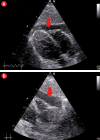Autosomal Dominant Polycystic Kidney Disease and Pericardial Effusion
- PMID: 30210723
- PMCID: PMC6131926
- DOI: 10.5001/omj.2018.78
Autosomal Dominant Polycystic Kidney Disease and Pericardial Effusion
Abstract
The autosomal dominant polycystic kidney disease (ADPKD) accounts for one out of 400-1000 live births, being a hereditary disorder with cystic and noncystic manifestations as well as extrarenal involvement. The pericardial effusion (PE) in the context of a patient with ADPKD is complex, and it is not entirely defined. Several theories have been proposed. The most accepted, so far, is linked to mutations in the PKD1 gene which can entail an abnormal production of matrix components, matrix-degrading enzymes, and inhibitors of metalloproteinases, and defects in connective tissue which would lead to an abnormal distensibility of the connective tissue. We report the case of a 35-year-old female Moroccan patient with the diagnosis of ADPKD associated with arterial hypertension who came into the Emergency Department with lower abdominal pain lasting for five days being diagnosed as salpingitis. Abdominal computed tomography scan with contrast showed both kidneys with several cystic images with a thin wall. A transthoracic echocardiogram revealed the presence of moderate PE more in the anterior aspect. A greater set of standard tests to rule out collagen vascular disease, rheumatoid diseases, autoimmune disorders, and malignancies was ordered. These tests yielded no abnormality. The association of ADPKD with PE is rare. The awareness of this connection by the emergency physicians is key to prevent misplaced concern.
Keywords: Chronic Renal Diseases; Pericardial Effusion; Polycystic Kidney, Autosomal Dominant.
Figures



References
-
- Davies F, Coles GA, Harper PS, Williams AJ, Evans C, Cochlin D. Polycystic kidney disease re-evaluated: a population-based study. Q J Med 1991. Jun;79(290):477-485. - PubMed
Publication types
LinkOut - more resources
Full Text Sources
Other Literature Sources
